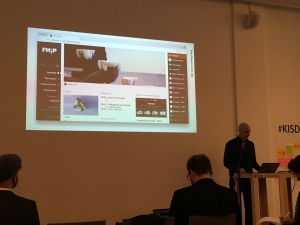eSTEeM
Centre for Scholarship and Innovation
Food for thought
20th December 2017
eSTEeM project leader, Nicole Lotz, shares her thoughts from the Digital Design Learning Conference 2017, which took place on the 14-15 December in Cologne, Germany.
Just before the 2017 Christmas break, KISD (Köln International School of Design) had organized a conference on Digital Design Learning to celebrate an achievement. The school has been developing their blended learning offerings for 10 years now. Following the motto: 'Designers build their own tools' the faculty started to adopt a blog environment to blend online and face-to-face learning, and has developed it into a well-used social learning environment called KISDspaces (https://vimeo.com/228662963).
 Simply put, the environment offers information on what students and staff currently do or have done (e.g. design projects and dissertations). It also offers an overview of events and resources that are available to them, such as labs or academic writing surgeries. Following the flat hierarchy of the school’s structure, both, staff and students can create project spaces. Project spaces present an overview of the design projects students currently work on in their Studios. Students at KISD always work collaboratively in teams of mixed levels of study and expertise. Projects will be achieved once the project is finished.
Simply put, the environment offers information on what students and staff currently do or have done (e.g. design projects and dissertations). It also offers an overview of events and resources that are available to them, such as labs or academic writing surgeries. Following the flat hierarchy of the school’s structure, both, staff and students can create project spaces. Project spaces present an overview of the design projects students currently work on in their Studios. Students at KISD always work collaboratively in teams of mixed levels of study and expertise. Projects will be achieved once the project is finished.
While some universities move further and further away from a blend of remote and face-to-face teaching towards sole online learning, other universities in Europe and the USA seem to get the mix right. Prof. Claudia Roeschmann, Director of the blended MFA programme in Design at the Texas State University highlighted that Design is taught in hybrid learning environments in which learners can choose their own blend. Some students attend more face-to-face weekend courses than others. Weekend intensive events such as ‘Creatons’ and ‘Hackatons’ are employed to develop skills and competency in book design, typography or team project work, which are difficult to teach at a distance.
The university needs to allow students to find their own ways to become critical, reflective and responsible citizen, which is more and more neglected in favour of a straight and easy path to a degree. But especially design education should set learners on such a path of exploration and discovery. Design actions have real world consequences. A design student should be allowed to take action and evaluate their impact in a safe space, that of the university. Through a partially guided trial and error process, students will find ways to change current situations to preferred futures that benefit all of society. And for this complex learning to happen, student have to struggle, they have to make mistakes, because we learn best when we fail. Design students should engage in difficult, empathetic, deep and long conversations. Bit-size chunks of information and content that dominate digital media need to be contextualized by conversations with a university academic, and some said, preferably face to face. This is creating intrinsically motivated learners, which was recognized as the key to retention in digital design learning.
For more reflections, please read Nicole's full report on the conference.
Image: Nicole Lotz
News
- An eSTEeM conference with a difference 7th May 2025
- Class of 2025 up and running 7th May 2025
- Registration now open for the 14th eSTEeM Annual Conference 18th March 2025
- Launch of the eSTEeM Annual Conference Proceedings 2024 13th February 2025
- 14th eSTEeM Annual Conference 2025 call for abstracts now open 14th January 2025